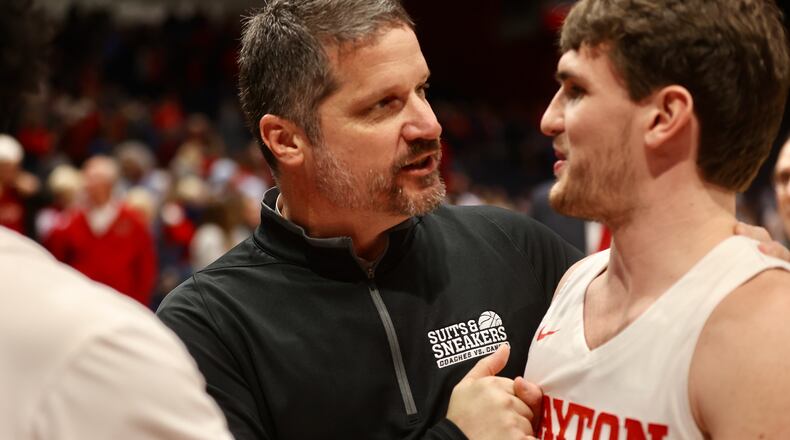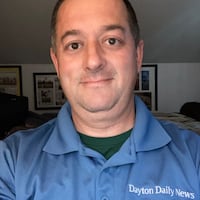A year later, Mulcahey bounced out of his seat with one fist raised in the air after Jordan Sibert’s 3-pointer against Boise State in the First Four.
In January 2021, Mulcahey threw his right arm in the air to celebrate Jalen Crutcher’s last-second 3-pointer against Saint Louis and then joined fellow staff members in making sure the players didn’t run onto the court to celebrate with less than a second remaining on the clock.
In November 2021, Mulcahey jumped into the air with both arms raised after Mustapha Amzil got the bounce on a buzzer-beater against Kansas.
“I’ve been spoiled,” Mulcahey said.
On other hand, Mulcahey doesn’t enter the center of the frame of the TV cameras except at the lowest moments for injured players. He helped carry Josh Cunningham off the court at Alabama in the second game of the 2016-17 season. Twice in the final minutes of a game against Brigham Young on Nov. 25, he was the first person to reach Kobe Elvis and then Malachi Smith after injuries and helped them to the locker room.
Although Mulcahey is near the action on gamedays, his most important work takes place behind the scenes in the training room, where he helps not only injured players on the way back to the court but mostly healthy players dealing with the aches, bumps and bruises everyone deals with over the course of a long season.
Mike Mulcahey one of the best trainers out there. Also, unfortunately, one of the busiest. He was with Cunningham in seconds. pic.twitter.com/3LdnARrjQK
— David Jablonski (@DavidPJablonski) November 15, 2016
Team MVP Mike Mulcahey with Josh Cunningham, who could play tonight after missing 21 games. pic.twitter.com/td5UjD6beD
— David Jablonski (@DavidPJablonski) February 10, 2017
Usually, an action shot of Mike Mulcahey (@MMULC) is a bad thing, but Josh Cunningham was OK after a hard fall Saturday at Fordham. pic.twitter.com/5781MHPjhS
— David Jablonski (@DavidPJablonski) January 27, 2019
Origin story
For Mulcahey, this life all started with an injury of his own when he was a sophomore football player at Badin High School in 1990.
“It was a kickoff,” Mulcahey said. “I got clipped from the side and tore my meniscus.”
Mulcahey said he wasn’t a key player that season. Badin went on to win the state championship without him. Meanwhile, he spent time with the athletic trainers, working his way back and learning to appreciate a job in which he could marry his love of sports with his interest in medicine and helping people.
Mulcahey attended Xavier University, where he was one of seven students who enrolled in the first year of the school’s athletic training program. That’s where he first met his mentor, Jody Jenike, Xavier’s head athletic trainer who retired in 2018 after 29 years at the school.
The best advice Mulcahey received from Jenike was, “Go do this somewhere else because there are 10 different ways to do this.”
That’s why Mulcahey earned his master’s degree from Western Michigan. There he met Nate Seymour, who would go on to become Dayton’s head athletic trainer and manager of sports medicine. Seymour was attending Western Michigan at the same time.
Mulcahey couldn’t find a job right away after finishing his master’s degree. At home in Cincinnati, he finally found work at a clinic at Big Bear Plaza in Lebanon, where he would work in the morning before going to a second job at Middletown High School in the afternoon.
Then in February of 1999, Mulcahey got a call from Xavier and an offer to work in Division I athletics. He worked with the baseball and volleyball teams until 2003 when he moved to men’s basketball. He worked for Thad Matta for one season and then was on the bench for Sean Miller’s entire five-year run. His last year at Xavier was Chris Mack’s first. The Musketeers played in the NCAA tournament all but one of those seasons.
Then for three years, with two young boys at home, Mulcahey took a step back from the grind. While at Xavier, he was also teaching and working side jobs at Great American Ball Park or road races. He slowed his pace and got into teaching for three years.
The teaching job lasted until 2013 when then Dayton coach Archie Miller called Mulcahey to offer him a job. When Miller left in 2017, Mulcahey stayed to work with Grant.
“It’s kind of like almost like a new marriage,” Mulcahey said. “You’ve got to kind of see where they’re coming from. They’ve got to see where you’re coming from. You can never be too high, never be too low. You’ve got to try to stay in the middle. In delivering information, you have to be mindful of the situation. You always have to be able to read a room. I want to be like the Maytag repairman because if I have no business then everybody’s happy.”
The key to working with any coach, Mulcahey said, is good communication.
“No surprises,” Mulcahey said. “Control what we can control. You’ve got to be more proactive than reactive. I like working with the strength coaches. Casey (Cathrall), specifically, here has been a godsend because he’s very forward thinking. So for me, it’s a combination of multiple factors. Neil Sullivan is an athletic director who supports us day in day out and the student-athlete welfare and their well being. Everybody has to be on the same page. All the oars in the water have to run in the same direction, and I feel fortunate I’ve had that almost my entire career.”
Dayton upgraded the training room at the Donoher Center in 2015. Mulcahey then described it as “1,000 percent state of the art. We have the best tools to keep these (players) healthy.”
Mulcahey brings a large chest of equipment on the road whenever Dayton travels. Among many items, he brings: three sets of recovery boots; a portable Stim machine that can treat four players at once, stimulating muscles and nerves massage guns; a Hyperice machine that can provide hot and cold treatment; and vibrating foam rollers. He’s always checking the market to see what new toys he can add to his arsenal.
“Everything’s recovery, recovery, recovery,” Mulcahey said. “During the grind of the season, they want to feel good. They don’t want the aches. Nobody wants aches. I don’t want the aches. These guys don’t want to go out there and try to perform that way.”
𝐌𝐢𝐜'𝐝 𝐔𝐩 🎤
— Dayton Basketball (@DaytonMBB) November 2, 2022
Mike Mulcahey #GoFlyers // @MMULC pic.twitter.com/BQKtnHcytr
‘A selfless person’
Although Mulcahey hasn’t earned many headlines over the years for his work, he’s often been mentioned in stories.
• In the first game of the 2018-19 season, Obi Toppin battled cramps in his college debut and ate pickles provided by Mulcahey to get back on the court.
“I’ve used pickles for years,” Mulcahey told Dayton Daily News columnist Tom Archdeacon after that game. “It’s something I learned from a physician a long time ago. It’s natural and it’s amazing how quickly it works for kids who are cramping.”
• In November 2015, Mulcahey bought three recovery boots to Orlando for the Advocare Invitational to help players get through three games in four days.
“We’re treating it like the NCAA Tournament,” Mulcahey said. “We’ll do whatever it takes.”
• In November 2014, Mulcahey adapted to life on the road by buying a trash can and filling it with ice for players so players could soak in it during the Puerto Rico Tip-Off.
Dayton players have benefitted for years from Mulcahey’s dedication. Former Dayton forwards Kendall Pollard and Cunningham, two players who spent more time than most with Mulcahey, talked last month about him often spending the night in Dayton so he could treat them early in the morning after games.
“Mike is literally God-sent,” said Pollard, who played for the Flyers from 2013-17. “He’s a selfless person. He puts everyone before him.”
Pollard said it was almost like having 24-hour care. He had knee surgery after his junior season and spent many hours with Mulcahey in the pool at the Dayton Rec Plex, working his way back when he couldn’t yet run. The care went beyond the physical side.
“I can’t thank Mike enough,” Pollard said. “I broke down crying my senior year because I knew my chances of playing in the NBA were slim and I would have to go overseas. I had all these injuries that really bothered me, and I wasn’t going to have my body right. We had a heart-to-heart conversation. You can come to Mike about anything.”
Cunningham suffered perhaps the most serious in-game injury of the last 10 season in the second game of the 2016-17 season at Alabama. He suffered a torn ligament in his left ankle after landing awkwardly following a dunk in the final seconds.
“If I remember correctly, I remember going down, and of course, Mike came out there,” Cunningham said, “and he was basically telling me, ‘I really don’t know what’s going on, but everything’s going to be OK.’ We thought it was a lot worse than what actually was. He was there by my side the whole time and did every test that he could to the best of his ability. He was just there comforting to me the whole time. Even on the flight back, I was next to Mike. He probably asked me 1,000 times, ‘You OK? Are you comfortable?’”
Mulcahey explained his thinking in moments such as those when he has to run onto the floor to comfort an injured player while also evaluating the injury.
“More than anything, you’ve got to get them to calm down,” he said. “In some situations that may not be able to happen. When Josh got hurt at Alabama, it was terrible. Your heart goes out to them. At the same point in time, your job is to make sure are they safe. Can we move them? Do we have to put them on a board? They react to how you react, and if you’re panicked and alarmed and not in control, then they’re going to be more likely to overreact.”
During the rehabilitation process, Mulcahey has been as much cheerleader as trainer. That’s where he develops the relationships that last long after the players leave UD.
“Nobody wants to be hurt,” he said, “and they’re working to get back to their craft. They’re vulnerable in those circumstances because they know there’s no guarantee.”
This is the sixth season Grant has worked with Mulcahey. He called him a superstar.
“Some of the most valuable people on your staff are your trainer and your strength coach (Casey Cathrall),” Grant said, “and we’ve got we got superstars in those areas. They do a great job, not only taking care of injuries when guys get hurt, and guys knowing that they have their best interest but just the care factor and the commitment and the dedication that they give to these young people and to our staff. They serve. They love what they do. Mike’s great. We’re very fortunate to have him.”
About the Author

